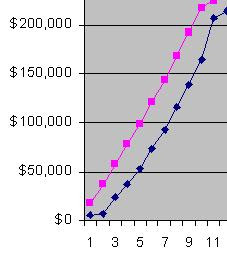Dollar Cost Averaging or Ringgit Kos Purata basically says you should invest the SAME Amount of money Periodically.
Just to remind all that in fundamental investment, you Buy Low Sell High.
So this is the Key Message :
when you don't know
when is the Lows and
when is the Highs
then you simply invest in
using Dollar Cost Averaging method
( wait for the next part )
Even if we don't know anything, we probably know an interesting market is either going up or down.
Let's say we invest $1,000 monthly into a dropping market from $10 to $1 in 10 months, we will lost a total of $7,071.03
Do the same in a rising market from $1 to $10 earns $19,289.68
So if you 'think' the chance of market going up and down is 50-50 ( meaning you don't know the market), then you are deciding between losing $7,000 and earning $19,000 from your $10,000 capital.
For some of you who invested before, you would know normally there is not such thing as invest $1,000 monthly. Most investment vehicles count in units. Meaning you can buy 200 units every month by "Default" but not the fix amount of money.
Let's see what happened,
1) your capital sum is $11,000 not just $10,000
2) you either lost $9,000 or earn $9,000
so if you think the up and down chancees are 50-50 ie. you don't know the market, then the decision to invest into this particular finance vehicle is still 50-50
( continue from above statements )
is lower risk than simply doing anything
and better than doing Nothing
and better than investing in constant units
Lastly you can further test the scenarios ie.
1) market goes down and then up
2) market goes up and then down
and the numbers tell me that I either lose $2,000 or earns $12,000

Put in your own scenarios that you think is related to you, then sum up all the "potential" returns or lost. In above spreadsheet, you can see that I have a chance of earning $22,000 even if I don't know the timing and simply invest in $1,000 monthly for 10 months.
If you are VERY EXCITED about the large numbers then don't be, it is unlikely to have any investment tool that goes from $1 to $10 or $10 to $1 in 10 months. In practice if you apply Dollar Cost Averaging correctly, you can expect 6-12% from Mutual Fund and 8-15% from Stock Market.


























